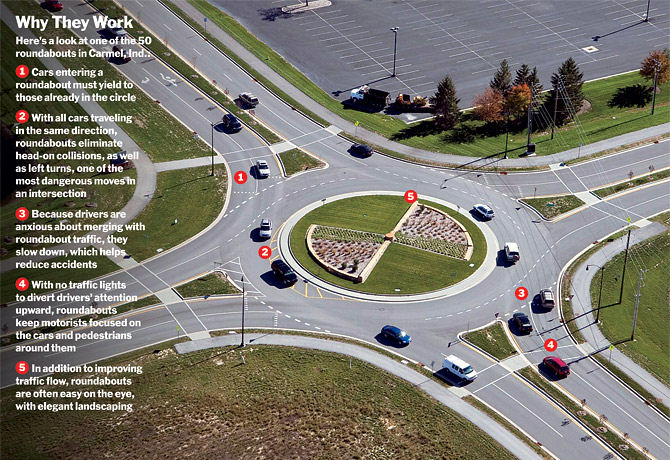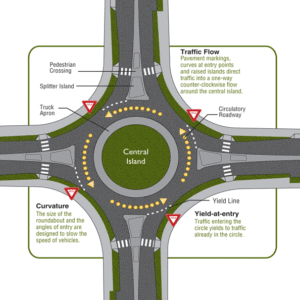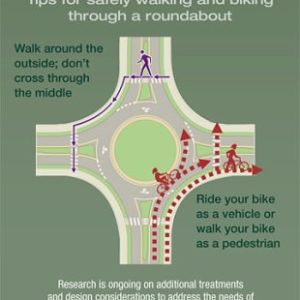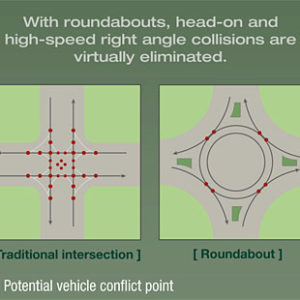The Delaware County Engineer, in cooperation with the Mid-Ohio Regional Planning Commission (MORPC), Franklin County Engineer, and the cities of Dublin, Gahanna and Hilliard have produced a short educational video on modern roundabouts. The video, Roundabouts: Keep In The Loop, includes information on how to correctly drive a modern roundabout and reasons why roundabouts are safer and more efficient than traffic signals for many intersections.
What is a Modern Roundabout?
Modern roundabouts are circular intersections that evolved from the older traffic circles in place across much of North America and Europe. Roundabouts differ from “rotaries” in that they are generally more compact and have slower travel speeds. Driving a modern roundabout may also be different than some traffic circles across the U.S., because rules of the right-of-way at some traffic circles and rotaries differ from others. This is in contrast to modern roundabouts, where operation is the same at each one, and the “yield when entering” principle is always in effect.

How do I Drive Through a Modern Roundabout?
1. Slow down when approaching a roundabout!
Modern roundabouts are designed for slower vehicle speeds, typically in the range of 15 to 25 mph. The slower vehicle speeds at roundabouts improve the safety of the roundabout, both for vehicles and for pedestrians.
2. Choose the appropriate lane before entering the roundabout.
On single lane roundabouts, there is usually only one entry lane from each direction. But for multi-lane roundabouts, you should make sure that you are in the proper lane when approaching the roundabout, just like at a traffic signal intersection. For instance, if you are going north and want to go west on the cross street, you should be in the left-most lane.
3. YIELD to pedestrians and bicyclists!
Pedestrians may be crossing the road as you enter or exit the roundabout. Give bicyclists some room if they are going through the roundabout in the traveled lanes. If you are riding a bike, you should go through the roundabout as a vehicle. If you are walking with a bike, use the sidewalks.
4. Vehicles already in the circle have the right-of-way…YIELD!
When entering the roundabout, yield to vehicles already in the circle. Once in the circle, you have the right-of-way and can circulate freely. In multi-lane roundabouts, be sure to stay in your own lane.
5. Always go around the central island in a counter-clockwise direction.
Never shortcut left around the center island – it is dangerous and illegal. Always proceed to the right of the center island and circulate in a counter-clockwise direction. If you are going north and want to go west, you will travel counter-clockwise around the circle, then exit to the west leg. Use your right-turn signal to indicate when you intend to exit the roundabout, and exit slowly watching for pedestrians.
6. Assume that trucks need all available space… do not pass them!
Roundabouts are designed to accommodate large trucks by letting them use both lanes of a multi-lane roundabout, so give them some space to get through.
7. Clear the roundabout to allow emergency vehicles to pass.
Do not stop in the middle of the circle. Exit the roundabout and pull over once you have cleared it with enough room for an emergency vehicle to pass you.
Why Roundabouts?
The primary reason for choosing roundabouts, compared to traffic signals is safety.
Modern roundabouts, compared to traffic signal controlled intersections, have been proven to reduce all crashes by 35%, and more importantly, reduce injury accidents by 76% and fatalities by 90% [1]. This is largely because of the lower speeds at roundabouts, compared to traffic signal intersections where vehicles often travel through a green light at full, free-flow speed. Accidents that do occur tend to be less severe, “fender-benders”.
Other reasons for using a roundabout instead of a traffic signal are improved traffic flow and reduced maintenance costs. Roundabouts can also be constructed at intersections with unusual geometry, such as 5-legged intersections or where two roads intersect at sharp angles. Signalizing these types of intersections is often difficult.
Roundabouts in Delaware County
As of 2018, there are over 25 roundabouts in operation within Delaware County. The Delaware County Engineer is taking a proactive approach to intersection safety by investigating roundabouts at all planned intersection improvements.
Where Can I Find More Information?
1. Federal Highway Administration
2. Michigan Department of Transportation
3. Arizona Department of Transportation
References:
[1] Roundabouts: A Safer Choice, U.S. Department of Transportation; Federal Highway Administration.


